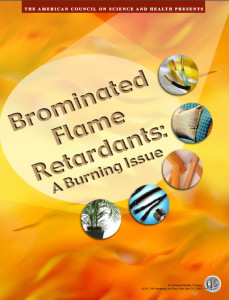 Senator Frank Lautenberg (D-N.J.) and 25 members of Congress recently sent a letter to EPA Administrator Lisa Jackson, urging quick action on regulations related to flame retardants. Supposedly, consumers are in grave dangerous from these chemicals, and EPA needs to act quickly. They lament that the EPA “must undertake lengthy rulemaking processes” before regulating these chemicals.
Senator Frank Lautenberg (D-N.J.) and 25 members of Congress recently sent a letter to EPA Administrator Lisa Jackson, urging quick action on regulations related to flame retardants. Supposedly, consumers are in grave dangerous from these chemicals, and EPA needs to act quickly. They lament that the EPA “must undertake lengthy rulemaking processes” before regulating these chemicals.
We should be glad that EPA has to take time to consider the science because their actions may do more harm that good if they act too quickly.
In fact, there isn’t any evidence that trace levels of flame retardants used to reduce fire risks in homes causes any health problems, whereas there is plenty evidence that they reduce dangerous fire risks.
A study by the American Council and Health shows that they hype about flame retardant risks could actually imperil public health. Author William P. Kucewicz explains:
Life-saving flame-retardant chemicals are under assault. Ignoring the vitally important role these compounds play in preventing or slowing fires, environmental activists advocate banning certain flame retardants on the grounds that biomonitoring studies have found trace amounts of the chemicals in humans, including in breast milk. They hope to get various governmental authorities in the U.S. and overseas to impose strict prohibitions on these flame-retardant chemicals.
At issue is a class of brominated flame retardants known as polybrominated diphenylethers (PBDEs). Within this group, three commercial mixtures of PBDEs are: penta-, octa-, and decaBDE. Each product is a mixture of diphenyl ethers with varying degrees of bromination. These particular PBDEs have widely and frequently been used as flame retardants in furniture foam (pentaBDE); plastics for TV cabinets, consumer electronics, wire insulation, and backcoatings for draperies and upholstery (decaBDE); and plastics for personal computers and small appliances (octaBDE). The chemicals increase valuable escape time in cases of fire by slowing both ignition and the rate of fire growth. (USEPA 2005a)
Efforts to ban these chemicals are deadly serious business. In the U.S., someone dies in a fire every two hours and ten minutes, and the vast majority (85 percent) of these non-firefighter, civilian deaths occur in home fires. The fire death rate is 14.8 persons for every one million Americans. (BFRIP 2002) In view of the public debate and regulatory reviews of PBDEs, a look at some flame-retardancy facts is in order.

